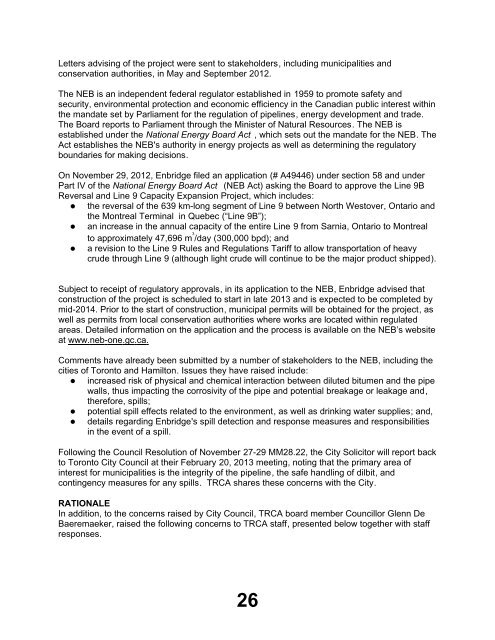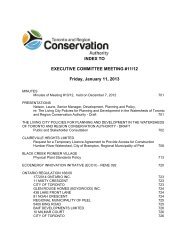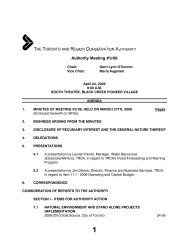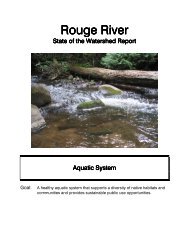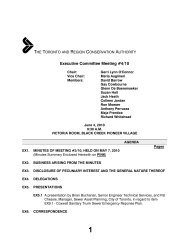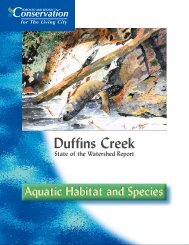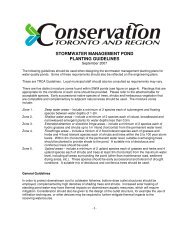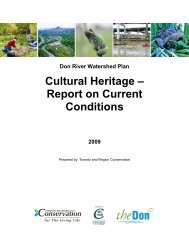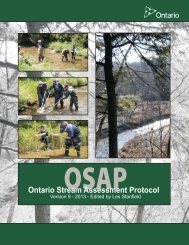1 - Toronto and Region Conservation Authority
1 - Toronto and Region Conservation Authority
1 - Toronto and Region Conservation Authority
You also want an ePaper? Increase the reach of your titles
YUMPU automatically turns print PDFs into web optimized ePapers that Google loves.
Letters advising of the project were sent to stakeholders, including municipalities <strong>and</strong>conservation authorities, in May <strong>and</strong> September 2012.The NEB is an independent federal regulator established in 1959 to promote safety <strong>and</strong>security, environmental protection <strong>and</strong> economic efficiency in the Canadian public interest withinthe m<strong>and</strong>ate set by Parliament for the regulation of pipelines, energy development <strong>and</strong> trade.The Board reports to Parliament through the Minister of Natural Resources. The NEB isestablished under the National Energy Board Act , which sets out the m<strong>and</strong>ate for the NEB. TheAct establishes the NEB's authority in energy projects as well as determining the regulatoryboundaries for making decisions.On November 29, 2012, Enbridge filed an application (# A49446) under section 58 <strong>and</strong> underPart IV of the National Energy Board Act (NEB Act) asking the Board to approve the Line 9BReversal <strong>and</strong> Line 9 Capacity Expansion Project, which includes:• the reversal of the 639 km-long segment of Line 9 between North Westover, Ontario <strong>and</strong>the Montreal Terminal in Quebec (“Line 9B”);• an increase in the annual capacity of the entire Line 9 from Sarnia, Ontario to Montrealto approximately 47,696 m 3 /day (300,000 bpd); <strong>and</strong>• a revision to the Line 9 Rules <strong>and</strong> Regulations Tariff to allow transportation of heavycrude through Line 9 (although light crude will continue to be the major product shipped).Subject to receipt of regulatory approvals, in its application to the NEB, Enbridge advised thatconstruction of the project is scheduled to start in late 2013 <strong>and</strong> is expected to be completed bymid-2014. Prior to the start of construction, municipal permits will be obtained for the project, aswell as permits from local conservation authorities where works are located within regulatedareas. Detailed information on the application <strong>and</strong> the process is available on the NEB’s websiteat www.neb-one.gc.ca.Comments have already been submitted by a number of stakeholders to the NEB, including thecities of <strong>Toronto</strong> <strong>and</strong> Hamilton. Issues they have raised include:• increased risk of physical <strong>and</strong> chemical interaction between diluted bitumen <strong>and</strong> the pipewalls, thus impacting the corrosivity of the pipe <strong>and</strong> potential breakage or leakage <strong>and</strong>,therefore, spills;• potential spill effects related to the environment, as well as drinking water supplies; <strong>and</strong>,• details regarding Enbridge's spill detection <strong>and</strong> response measures <strong>and</strong> responsibilitiesin the event of a spill.Following the Council Resolution of November 27-29 MM28.22, the City Solicitor will report backto <strong>Toronto</strong> City Council at their February 20, 2013 meeting, noting that the primary area ofinterest for municipalities is the integrity of the pipeline, the safe h<strong>and</strong>ling of dilbit, <strong>and</strong>contingency measures for any spills. TRCA shares these concerns with the City.RATIONALEIn addition, to the concerns raised by City Council, TRCA board member Councillor Glenn DeBaeremaeker, raised the following concerns to TRCA staff, presented below together with staffresponses.26


